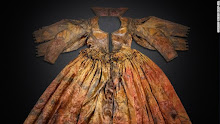In my last book, The End of the Fairy-Tale Bride:
For Better or Worse, How Princess Diana Rescued the Great White Wedding, I
looked at the glittering cultural influences of Diana and Prince Charles’
wedding in 1981. With the reassuring order of its grand rituals and symbolic pomp, the wedding captured the attention of a society in chaos reeling from the rebellious
cultural upheavals of the 1960s and ‘70s. Then with its fairy-tale longings and
a beautiful bride with a light about her—a young woman who became a real
princess of a legendary kingdom—the wedding also captured the wonder of some
deeply feminine ethos around the world. It was certainly the catalyst of a
life-changing occurrence in my life. On the shimmering wave between the two
Windsor weddings that decade, I designed a shop for the emerging “modern
woman”—a woman more educated, independent and sexually experienced than her
mother’s generation—who was now considering marriage enfolded in the wedding
pageantry of another time and place. And together, along with an atelier full
of talented women designers, we navigated the changing sensibilities of being
feminine, womanly, confident and autonomous.
After Diana’s wedding, however, her soap-opera life
held little interest for me except for her moments of open-hearted instincts,
reaching out to the ‘forbidden’ sick, touching the untouchables, when her light
was unmistakable. Then at summer’s end in 1997 with news of her death, that
global surge of disbelief and grief reached the serenity of my Atlanta courtyard
on a still Sunday morning. Deeper than simply emotional, it was more like being
forcefully struck, breaking some vital connection. On some cosmic level, it was
the break needed energetically for such an expansive awakening. (Is this the
phenomenon that happens to us at the death of a person whose aura and larger-than-life
images are all we know?) “Whom the gods love, die young,” Lord Bryan wrote.
Consequently, in the days to follow that jolting headline
was when I became truly intrigued by Diana. “For many people…Princess Diana has
become far more interesting since her death than ever she was during her life,”
shared English writer and Jungian analyst Warren Colman. That’s when I began to
look beyond appearances to the person “who could inspire such an enormous
response in so many people”—the real person distinct from the image. Even
though I felt it was that “real person” I’d caught sight of years before as a floating-on-light,
goddess-reminiscent bride. ~
[Excerpt from the Introduction, "Diana As Messenger," of my book-in-progress, tentatively titled, A Memory of Beauty: The Spiritual Mission of a Princess...more excerpts to come.]




















No comments:
Post a Comment